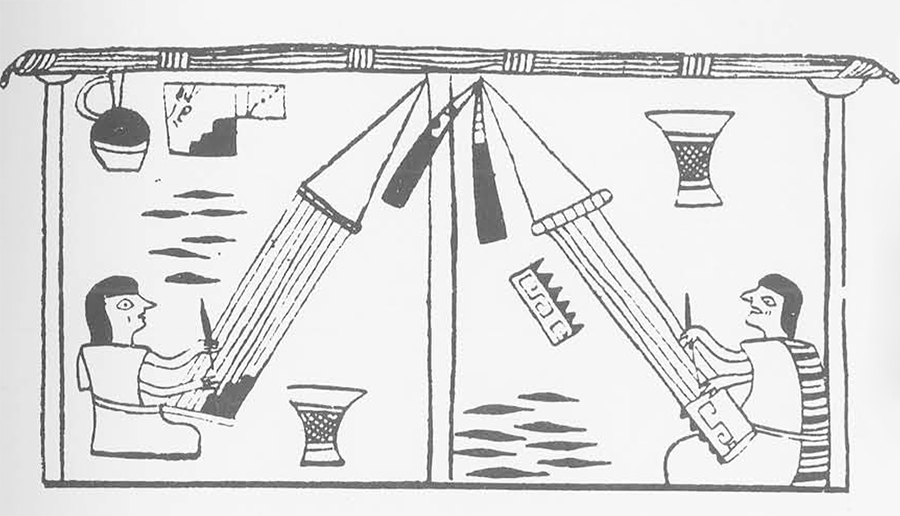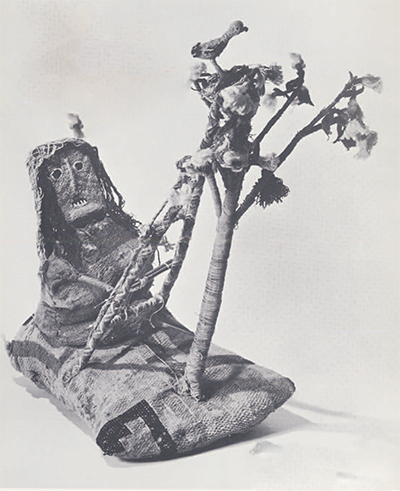
The Museum has recently acquired a very unusual specimen. It is a pillow on which is seated an effigy of a woman working at a loom suspended on an A-frame which leans against a tree. In the tree there is a bird’s nest with a long-legged fledgling standing in it. It is difficult to find a single word that describes this curious and, in one specific way, unique object. Those of use who have worked with it in order to put it on exhibition have been calling it informally the “Weaving Lady.” We have no information whatever as to its exact provenience but we do know that it comes from Peru and that it was quite certainly a grave offering. This is apparent because of its good condition and the fact that it is inconceivable that it could have been so well preserved had it not been carefully placed in a grave or tomb somewhere on the arid Peruvian coast. By comparison with similar effigies, we can also be fairly certain that it comes from the Chancay Valley just north of Lima and, but the style of the textile covering the pillow, we are also quite certain that it dates from a late period, probably from the one known as Late Chancay. This would make it approximately seven hundred years old.
In the collection of Dr. Fred Olsen, there is a very similar tree, in which there are several birds. It is known that this tree was found in the Chancay Valley and the workmanship is so similar to that of the “Weaving Lady’s” tree that we can be quite sure that they both came from the same general locality. The two trees represent the same species. They can be identified by the presence on the branches of small, woven ovals, from three quarters of an inch to an inch and a half long, representing large seed pods. These are characteristic of a native Peruvian tree called Pacay. Botanically, this pod-bearing tree is called Inga pacay. The pods were, and still are, eaten by the Indians of coastal Peru. The seeds are surrounded by a pulp that has a sweetish and quite pleasant taste. Many remains of the pods have been found in the rubbish heaps along the coast, and the much earlier Mochica people of the north coast made pottery reproductions of them. One from the Museum’s collection is shown here.
The construction of the “Weaving Lady” involved five separate operations and the combination of these elements. First, the pillow itself was constructed by covering a mass of leaves and rushes with a brocaded fabric which was simply folded around the stuffing and sewn on both sides and at the back of the pillow, leaving the front unseamed. At first glance, the pattern appears to be embroidered but, on closer examination, it is apparent that it was woven into the fabric on a loom. The basic fabric is of cotton yarn, visible in worn patches and as narrow, unbrocaded strips separating the colored, brocaded areas of the design. These are black, yellow, red, and a faded brown arranged in an interlocking step pattern.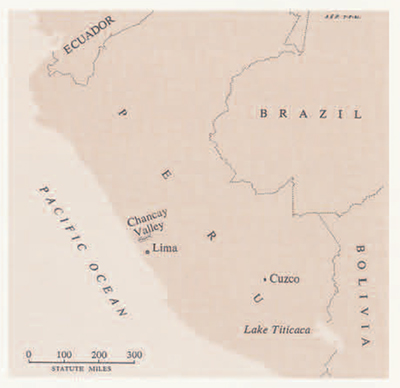
The weaver sitting before her loom on the pillow is, in effect, a doll-like effigy of a woman. Basically, she was constructed of heavy leaves that can be seen just under her chin. these appear to be the dried and scraped leaves of a plant of the maguey family. They resemble the leaves of the century plant. There is a little additional padding of rushes and leaves. Her head was made of some fairly hard but not inflexible material which could not be identified without cutting the material of her face or headdress. The hair of black woolen yarn is covered by a loosely woven head shawl of yellow and black wool. All the warp threads are yellow with widely separated paired wefts of yellow and black. To make the face, the basic material of the head was covered with what appears to be a cotton fabric only visible just under the chin. This was covered by needlework in pink, red, dull yellow, black, and white in woolen yarn. Both the nose and the chin were built up in relief. It is not clear whether the needleworking was done over a packing to produce this effect, but apparently it was not. The zone of red and yellow triangles and bands extending from the nose downward across the face and beside the eyes must represent face painting, or, with much less likelihood, tattooing. The arms were made of what appear to be sticks with fingers of split rushes, all wrapped around with pink woolen yarn. Just how they were attached to the body is not clear since the shoulders are covered by her garment. This consists of a plain-woven fabric with widely spaced cotton warps and woolen wefts in green, pink, and yellow forming bands around the figure. To make the sack-like dress, the cloth was sewn up the left side and over the shoulders and elbows to the forearms, forming sleeves of a sort on each side, and leaving a slit for the neck. This is quite different from the typical poncho-like tunics most characteristic of Peruvian costume. It seems unlikely that it represents a garment actually worn by the Indians. Normally that would be a shirt or a dress made of a single piece of cloth folded in two, with a vertical slit for the neck and the two sides sewn together, leaving armholes at the top–a poncho with the sides nearly closed. Apparently the figure was never sewn to the pillow but was attached to the loom by threads from the hands. At least two very similar figures are known, one of which is also sitting on a pillow. neither is associated with a tree or loom.
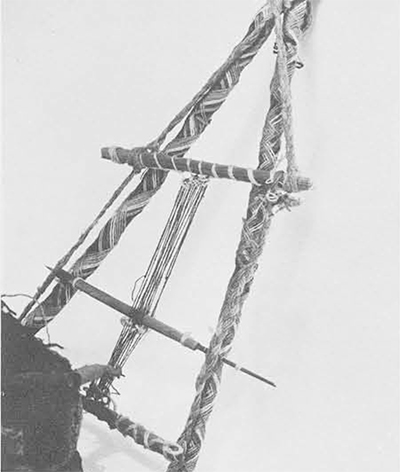
The tree was made of rushes bunched together and wrapped with light brown cotton thread. The branches were made in the same way, with the white blossoms and woven seed pods tied on and, in some cases, simply held in place by the wrapping. All the blossoms are of wool, including a single red one; brown seed pods are also woolen but the yellow seed pods are of plain woven cotton. The base of the tree was set into the pillow through a hole in the brocade. The bird’s nest is a crude basket made of split plant fiber, possibly coarse grass, held together by a white cotton thread. The basic material of the fledgling cannot be seen but it is quite firm and may perhaps have been carved from wood. It was covered by pink woolen wrapping on the legs, with a partially wrapped, partially needleworked body and neck of mauve wool. The wings and tail are black and white wool; the eyes are black and yellow wool, as is the needlework beak.
The most remarkable feature of the whole depiction is the A-frame itself. According to Dr. Junius Bird of the American Museum of Natural History, one of the world’s leading authorities on Peruvian weaving, this method of supporting the loom is unique in Peruvian culture. The frame consists of two reeds or canes lashed together at the top and held apart at the base by the lower bar of the loom. If our model reflects actual usage, and of this we cannot be completely sure, the lower loom bar would have had to be fastened to the A-frame, not to separate its legs which could easily have been firmly planted in the ground, but to maintain tension on the warps. Each of the canes was diagonally wrapped with woolen yarns to form the decorative pattern. The colors are red, yellow, white, and black.
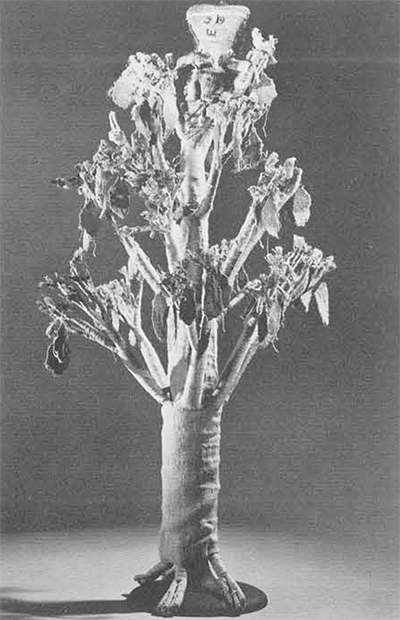
The loom itself is a good example of the typical Peruvian two-bar type. Normally, such looms were attached at the upper end to a tree or post exactly as our model loom is attached to the upper end of the A-frame. The lower bar of the loom, however, was normally equipped with a backstrap which encircled the weaver’s body in such a way that she was able to control the tension of the warp threads simply by slight movements forward or backward. In this case, the braided cords of red and yellow wool that support the upper loom bat were continued down the length of each leg of the A-frame and attached at the base. This unique method of mounting the loom provides no control of warp tension except by relashing the lower bar or by adjusting the supporting cords at the top.
There are several peculiarities in the way the miniature loom is arranged. What appears to be a heddle rod under the warp threads was lashed to a shorter shed rod which, in actual use, would have prevented proper functioning of the loom. This may have been done simply to keep these two elements in position in the model. The weaver seems to have begun at both the bottom and the top, which also seems unusual. At the bottom, a few rows of yellow woolen weft thread have been woven across the brown cotton warps. At the top, four or five rows of white woolen wefting have been inserted. The heddle rod, if such it is, is attached to the warps of one shed by white woolen yard but its position under the warping seems out of place. There is also no batten. These peculiarities may, of course, represent a sort of model maker’s license with an attempt being made to give a reasonable impression of a working loom without concern for technical accuracy. Whatever may be the case, the entire setup represents a most interesting divergence from normal Peruvian practice.
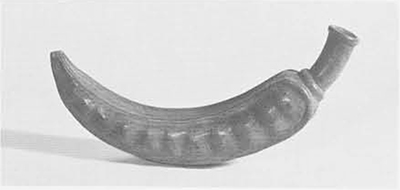
We can only speculate as to the purpose for which the “Weaving Lady” with her loom was made. Since there is no doubt that it was found in a grave, one can imagine that it was put together to accompany a woman who had been an active, and very probably, an outstanding weaver. It may, of course, also have been intended to represent a weaver whose services could be utilized in the next world by the deceased of whatever sex. Cloth was highly valued by the ancient Peruvians, attested by numerous references to its production and distribution as tribute in Inca times. For whatever purpose the “Weaving Lady” was made, she is a most engaging and interesting example of the art of the loom in ancient Peruvian life.
